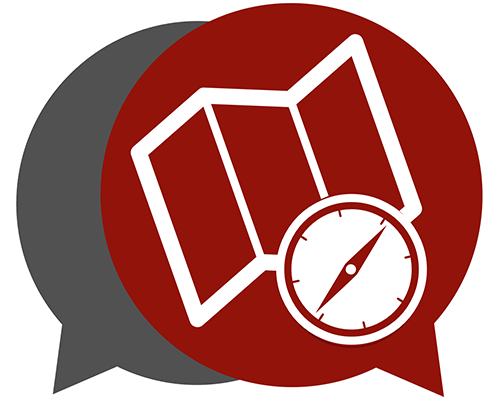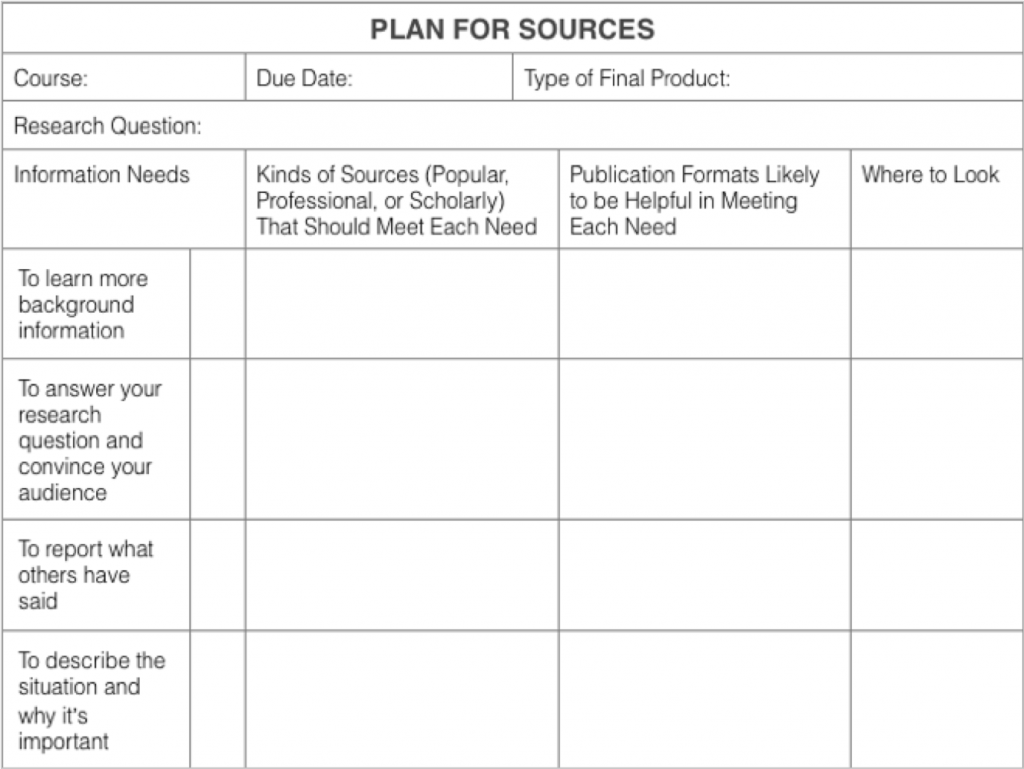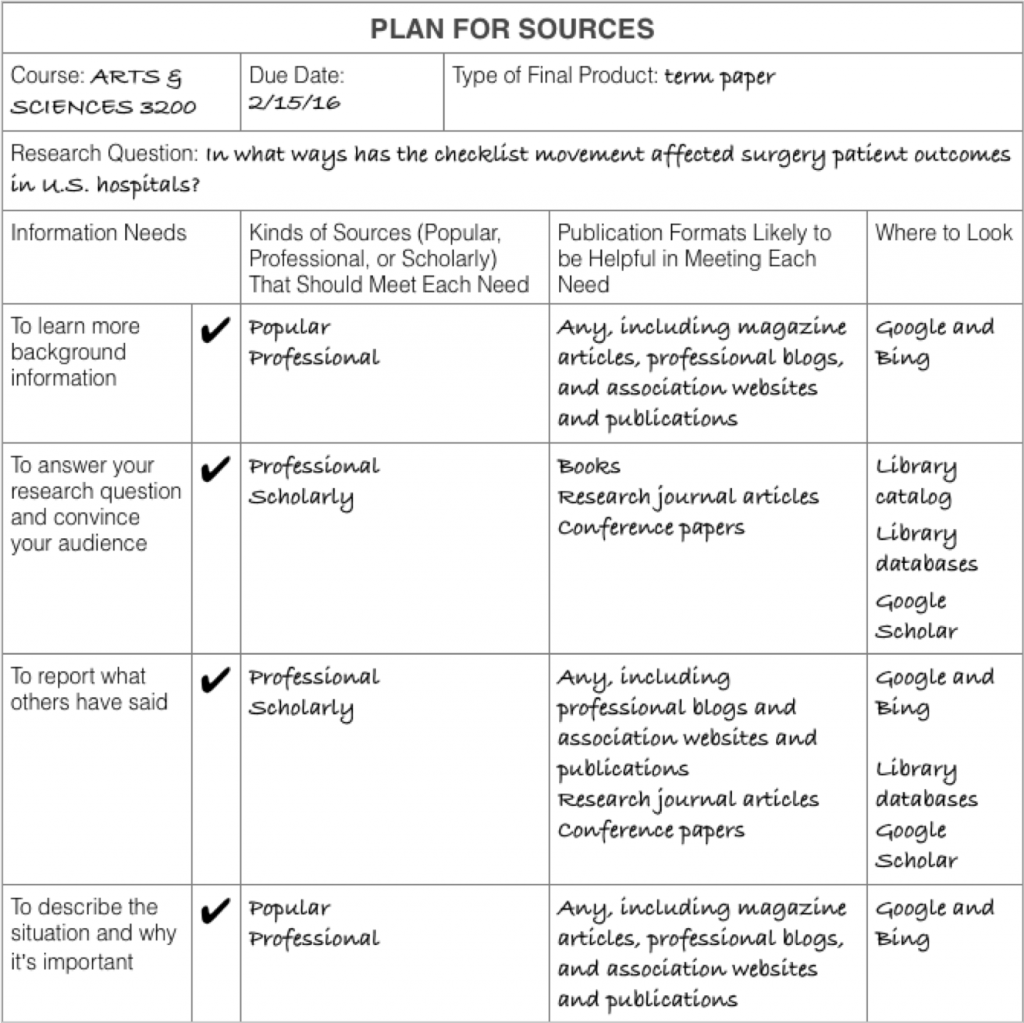96 Sources and Information Needs
Teaching & Learning and University Libraries
Sources and Information Needs

This section and the section on Types of Sources work together. That’s because knowing the kinds of information in each category of sources will help you choose the right kind of information to meet each of your information needs. And some of those needs are very particular.
Information needs are why you need sources. Meeting those needs is what you’re going to do with sources as you complete your research project.
Here are those needs:
- To learn more background information.
- To answer your research question(s).
- To convince your audience that your answer is correct or, at least, the most reasonable answer.
- To describe the situation surrounding your research question for your audience and explain why it’s important.
- To report what others have said about your question, including any different answers to your research question.
Tip:
For another way to think about the work your sources do, see Roles of Research Sources.
The verbs in the list of information needs above tell you exactly how you’ll use sources to carry out your research and create your final product: to learn, answer, convince, describe, and report. But you won’t be doing any of that alone.
Your sources will give you information with which to reason. They’ll also give you direct quotes and information to summarize and paraphrase as you create your final product. In other words, your sources will support you every step of the way during your research project.
Needs and Final Products
Background information may seldom appear directly in any final product. But meeting each of the other information needs will result in written sections of a term paper. For final products other than term papers, you’ll have the same needs and will use sources to meet them. But not all needs will result in a section of your final product.
Posters & Information Needs
On a poster about your own original research, you aren’t likely to have room to describe the situation surrounding your research question and why the question is important. That same lack of space may mean you do not report what others have said about your question. But that doesn’t mean you didn’t meet those needs and others as you carried out your research—unlike a term paper or journal article, the poster format in which you reported it just had more limited space.
For instance, in order to justify doing the research to yourself and your professor, you probably started by meeting the information need to describe the situation and why it is important. Your instructor may have you turn in that justification. And in order to do research based on what has already been found out, you will have studied what others have already reported. You also had to do that in order to make your answer to your research question more believable. But that doesn’t mean you had room on your poster to say you met those needs.
Activity: Sources and Information Needs
Sources to Meet Needs
Because there are several categories of sources (see Types of Sources), the options you have to meet your information needs can seem complex.
Our best advice is to pay attention to when only primary and secondary sources are required to meet a need and to when only professional and scholarly sources will work. If your research project is in the arts, also pay attention to when you must use popular sources, because popular sources are often primary sources in the arts.
These descriptions and summaries of when to use what kind of source should help.

To Learn Background Information
When you first get a research assignment and perhaps for a considerable time afterward, you will almost always have to learn some background information as you develop your research question and explore how to answer it.
Sources from any category and from any subgroup within a category – except journal articles – can meet students’ need to learn background information and understand a variety of perspectives. Journal articles, are usually too specific to be background. From easy-to-understand to more complex sources, read and/or view those that advance your knowledge and understanding.
For instance, especially while you are getting started, secondary sources that synthesize an event or work of art and tertiary sources such as guidebooks can be a big help. Wikipedia is a good tertiary source of background information.
Sources you use for background information don’t have to be sources that you cite in your final report, although some may be.
Sources to Learn Background Information
- Quantitative or Qualitative: Either—whatever advances your knowledge.
- Fact or Opinion: Any—whatever advances your knowledge.
- Scholarly, Professional, or Popular: Any—whatever advances your knowledge.
- Primary, Secondary, or Tertiary: Any—whatever advances your knowledge.
- Publication Format: Any—whatever advances your knowledge.
One important reason for finding background information is to learn the language that professionals and scholars have used when writing about your research question. That language will help you later, particularly when you’re searching for sources to answer your research question.
To identify that language, you can always type the word glossary and then the discipline for which you’re doing your assignment in the search engine search box.
Here are two examples to try:
(Putting a phrase in quotes in most search boxes insures that the phrase will be searched rather than individual words.)

To Answer Your Research Question
You have to be much pickier with sources to meet this need because only certain choices can do the job. Whether you can use quantitative or qualitative data depends on what your research question itself calls for.
Only primary and secondary sources (from the category called publication mode) can be used to answer your research question and, in addition, those need to be professional and/or scholarly sources for most disciplines (humanities, social sciences, and sciences). But the arts often require popular sources as primary or secondary sources to answer research questions. Also, the author’s purpose for most disciplines should be to educate and inform or, for the arts, to entertain and perhaps even to sell. (As you may remember, primary sources are those created at the same time as an event you are researching or that offer something original, such as an original performance or a journal article reporting original research. Secondary sources analyze or otherwise react to secondary sources. Because of the information lifecycle, the latest secondary sources are often the best because their creators have had time for better analysis and more information to incorporate.)
Example: Quantitative or Qualitative Data
Suppose your research question is “How did a a particular king of Saudi Arabia, King Abdullah, work to modernize his country?”
That question may lend itself to qualitative descriptive judgments—about what are considered the components of modernization, including, for instance, what were his thoughts about the place of women in society.
But it may also be helped by some quantitative data, such as those that would let you compare the numbers of women attending higher education when Abdullah became king and those attending at the time of his death or, for instance, whether manufacturing increased while he reigned.
So looking for sources that provide both quantitative and qualitative information (not necessarily in the same resource) is usually a good idea.
If it is not clear to you from the formats of sources you are assigned to read for your course, ask your professor which formats are acceptable to your discipline for answering your research question.
Sources to Answer Your Research Question
- Quantitative or Qualitative: Will be determined by the question itself.
- Fact or Opinion: Professional and scholarly for most disciplines; the arts often use popular, as well.
- Scholarly, Professional, or Popular: Professional and scholarly for most disciplines; the arts often use popular, as well.
- Primary, Secondary, or Tertiary: Primary and secondary.
- Publication Format: Those acceptable to your discipline.

To Convince Your Audience
Convincing your audience is similar to convincing yourself and takes the same kinds of sources—as long as your audience is made up of people like you and your professor, which is often true in academic writing. That means using many of those sources you used to answer your research question.
When your audience isn’t very much like you and your professor, you can adjust your choice of sources to meet this need. Perhaps you will include more that are secondary sources rather than primary, some that are popular or professional rather than scholarly, and some whose author intent may not be to educate and inform.
Sources to Convince Your Audience
- Quantitative or Qualitative Data: Same as what you used to answer your research question if your audience is like you and your professor. (If you have a different audience, use what is convincing to them.)
- Fact or Opinion: Those with the purpose(s) you used to answer your research question if your audience is like you and your professor. (If you have a different audience, you may be better off including some sources intended to entertain or sell.)
- Scholarly, Professional or Popular: Those with the same expertise level as you used to answer the question if your audience is like you and your professor. (If you have a different audience, you may be better off including some popular.)
- Publication Mode: Primary and secondary sources if your audience is like you and your professor. If you have a different audience, you may be better off including more secondary sources than primary.
- Publication Format: Those acceptable to your discipline, if your audience is like you and your professor.

To Describe the Situation
Choosing what kinds of sources you’ll need to meet this need is pretty simple—you should almost always use what’s going to be clear and compelling to your audience. Nonetheless, sources intended to educate and inform may play an out-sized role here.
But even then, they don’t always have to educate and inform formally, which opens the door to using sources such as fiction or the other arts and formats that you might not use with some other information needs.
Sources to Describe the Situation
- Quantitative or Qualitative: Whatever you think will make the description most clear and compelling and your question important to your audience.
- Fact or Opinion: Often to educate and inform, but sources don’t have to do that formally here, so they can also be to entertain or sell.
- Scholarly, Professional, or Popular: Whatever you think will make the description most clear and compelling and your question important to your audience.
- Primary, Secondary or Tertiary: Whatever you think will make the description most clear and compelling and your question important to your audience. Some disciplines will not accept tertiary for this need.
- Publication Format: Whatever you think will make the description most clear and compelling and your question important to your audience. Some discipline will accept only particular formats, so check for your discipline.

To Report What Others Have Said
The choices here about kinds of sources are easy: just use the same or similar sources that you used to answer your research question that you also think will be the most convincing to your audience.
Sources to Report What Others Have Said
- Quantitative or Qualitative: Those sources that you used to answer your research question that you think will be most convincing to your audience.
- Fact or Opinion: Those sources that you used to answer your research question that you think will be most convincing to your audience.
- Scholarly, Professional, or Popular: Those sources that you used to answer your research question that you think will be most convincing to your audience.
- Primary, Secondary, or Tertiary: Those sources that you used to answer your research question that you think will be most convincing to your audience.
- Publication Format: Those sources that you used to answer your research question that you think will be most convincing to your audience.
Activity: Meeting Your Information Needs
Planning Your Sources
Okay, so once you know what kinds of sources you need to meet your information needs, where should you look for them? Once more, thinking about categories can help.
Where sources are located is generally organized by audience expertise level—by whether they are popular, professional, or scholarly sources. Popular and professional are often grouped together. But scholarly sources tend to hang out by themselves. (That’s why searching Google Scholar locates more of them than just plain old Google, and an academic library has more scholarly sources than a public library.) Source Locator can help you see where sources of every audience expertise level (popular, professional, and scholarly) are located. Check it out.
Even if you are not using our planning table, Bbefore you start looking, try the Plan for Sources table below along with the suggestions made in this section to think through what sources you’ll need for your own research project. (There’s also an example plan for sources filled in for a term paper.) Having your Plan for Sources always at your side while you search for sources will guide where you look and what you’re willing to accept. It will help you keep track of whether you have found the right resources.
Also take a look at our Source Locator, whose link is below.

needs helps you target your search. You can download the Plan for Sources
table at http://go.osu.edu/planforsources.
You can download the table at http://go.osu.edu/planforsources, then fill it out with the help of our Source Locator. Using this table doesn’t mean you can’t change your mind if you later find another kind of source that looks too good to pass up. But making a plan first will insure that you don’t just grab any source you come across. The few minutes you take to complete the table will save you time later. And it’s nice to have a plan all in one place that you can put into action!
Example: Sample “Plan for Sources” Table


